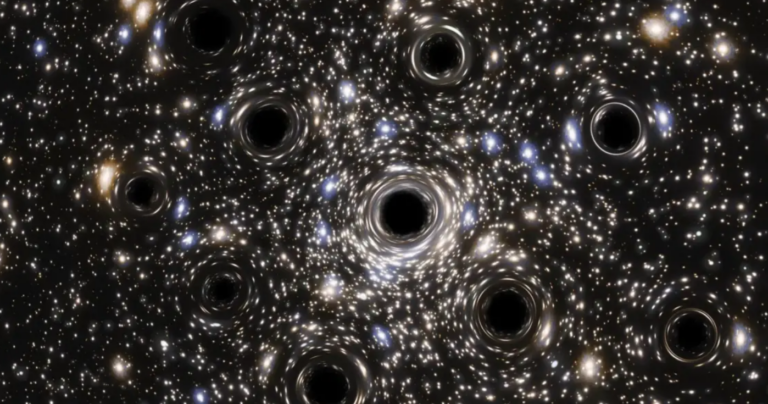Astrophysicists estimate that there are 40 quintillion small black holes lurking in the universe.
Scientists have attempted to quantify the number of “small” black holes in the universe. Not surprisingly, the number is fairly large.
This might seem like a herculean task due to the difficulties involved in identifying black holes. These cosmic giants, which are as dark as the space they inhabit, are detectable only under certain circumstances – if only they twist light, or devour gases and stars that stray too close to them, or if only they merge in titanic collisions that emit gravitational waves.
However, this has not stopped scientists from at least trying to make educated guesses about the quantity. Astrophysics have come up with a new method of calculating the number of black holes that are three to ten times the mass of the sun in space and the new method is published in The Astrophysical Journal.
The result is astonishing: the most recent statistic gives a figure of 40,000,000,000,000,000,000,000, that is, forty quintillion stellar-mass black holes that composes one per cent of normal matter in the observable universe.
Well, how did the scientists arrive at this figure?From the evolution of stars, the researchers were able to deduce the frequency at which stars in the universe convert into black holes, as stated by lead author Alex Sicilia, an astrophysicist at the International School of Advanced Studies (SISSA) in Trieste, Italy.
“This is one of the first and most accurate measures of the black hole mass function across cosmic time, built from scratch,” Sicilia said in a statement.
The work by the astrophysicists focused on analyzing the life cycles of stars in the universe to establish the conditions required for the formation of black holes. Their study has shown that the star needs to be 5 to 10 times the mass of the sun to go through this change. These massive stars go through a series of fusion where they burn elements such as silicon and magnesium in the center of the star before they die.
However, the star’s fate transforms drastically as soon as the fusion process starts producing iron. Unlike the previous reactions, iron fusion absorbs more energy than it produces and the star ceases to possess the necessary energy to withstand the incredible forces that come with the massive weight of the entire structure. The star is forced to contract, the core plus all the matter around it is squeezed into a singularity, a point of zero dimensions and infinite density.
This singularity indicates the creation of a black hole – an object in space that has a gravity so strong that nothing, not even light, can get out of it. The point at which escape becomes physically impossible is called the event horizon. To arrive at their estimations, the astrophysicists built the model of the universe as good as the sizes of stars and the frequency of their formation. This model integrated previous statistical information about galaxies including their size and composition, size of gas clouds where stars are formed.
Studying the life and death of star candidates in relation to their characteristics such as mass and metallicity was key in determining the percentage of candidates that ultimately form black holes. The first thing the researchers did was to determine the rate at which stars that could turn into black holes are formed. To this end, they included binary star systems and also the collision and merging rates of black holes without duplication. Moreover, the effects of these mergers were taken into consideration by the researchers in terms of the distribution of black hole mass in the universe as well as consumption of gas around black holes.
Based on these parameters, the researchers crafted a model that predicted the population and size distribution of stellar-mass black holes in the universe and history, leading to these discoveries. To test their model, they overlaid their estimates with data gathered from gravitational waves originating from black hole and binary star systems.
This new estimate was developed to help astronomers understand the fascinating mysteries involving the early universe. One of them is the evolution of seeds of so-called supermassive black holes, which are at least millions or even billions of times heavier than stellar-mass black holes discussed in this work, within a billion years after the Big Bang.
Exploring the creation of small black holes in the early universe is what the researchers aim to do in order to understand the formation of their large counterparts. This is because these colossal black holes formed from the merging of smaller black holes; these are called seeds.
According to Lumen Boco, an astrophysicist at SISSA, “Our work provides a robust theory for the generation of light seeds for supermassive black holes at high redshift [further back in time], and can constitute a starting point to investigate the origin of “heavy seeds,” that we will pursue in a forthcoming paper.”
Do not forget to share your opinion with us to provide you with the best posts !




0 Comments